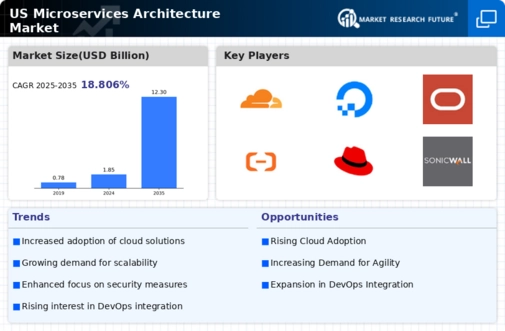The microservices architecture market is currently characterized by a dynamic competitive landscape, driven by the increasing demand for agile and scalable software solutions. Major players such as Amazon (US), Microsoft (US), and Google (US) are at the forefront, leveraging their extensive cloud infrastructures to enhance service delivery. Amazon (US) focuses on continuous innovation in its AWS platform, while Microsoft (US) emphasizes integration with its Azure services to provide seamless microservices solutions. Google (US) is strategically positioning itself through its Kubernetes platform, which facilitates container orchestration, thereby enhancing operational efficiency. Collectively, these strategies foster a competitive environment that prioritizes technological advancement and customer-centric solutions.
Key business tactics within this market include optimizing supply chains and localizing service offerings to meet regional demands. The competitive structure appears moderately fragmented, with numerous players vying for market share. However, the influence of key players is substantial, as they set industry standards and drive technological advancements. This competitive interplay encourages smaller firms to innovate and differentiate their offerings, thereby enriching the overall market landscape.
In October 2025, Amazon (US) announced the launch of a new microservices framework designed to simplify application development for enterprises. This initiative is significant as it aims to reduce the complexity associated with microservices deployment, potentially attracting a broader customer base. By streamlining the development process, Amazon (US) reinforces its position as a leader in cloud services, further solidifying its competitive edge.
In September 2025, Microsoft (US) unveiled a partnership with a leading AI firm to enhance its Azure microservices capabilities. This collaboration is pivotal, as it integrates advanced AI functionalities into microservices, enabling businesses to leverage data-driven insights for improved decision-making. Such strategic alliances not only enhance Microsoft’s service offerings but also reflect a broader trend of integrating AI into cloud solutions, which is likely to reshape customer expectations.
In August 2025, Google (US) expanded its Kubernetes ecosystem by acquiring a startup specializing in microservices security. This acquisition is crucial, as it addresses growing concerns regarding security in microservices architectures. By enhancing its security offerings, Google (US) not only strengthens its Kubernetes platform but also positions itself as a comprehensive solution provider in the microservices domain, appealing to enterprises prioritizing security.
As of November 2025, current trends in the microservices architecture market include a pronounced focus on digitalization, sustainability, and the integration of AI technologies. Strategic alliances are increasingly shaping the competitive landscape, fostering innovation and collaboration among key players. Looking ahead, it appears that competitive differentiation will evolve, shifting from price-based competition to a focus on innovation, technological advancements, and supply chain reliability. This transition suggests that companies that prioritize these elements will likely emerge as leaders in the microservices architecture market.

















Leave a Comment